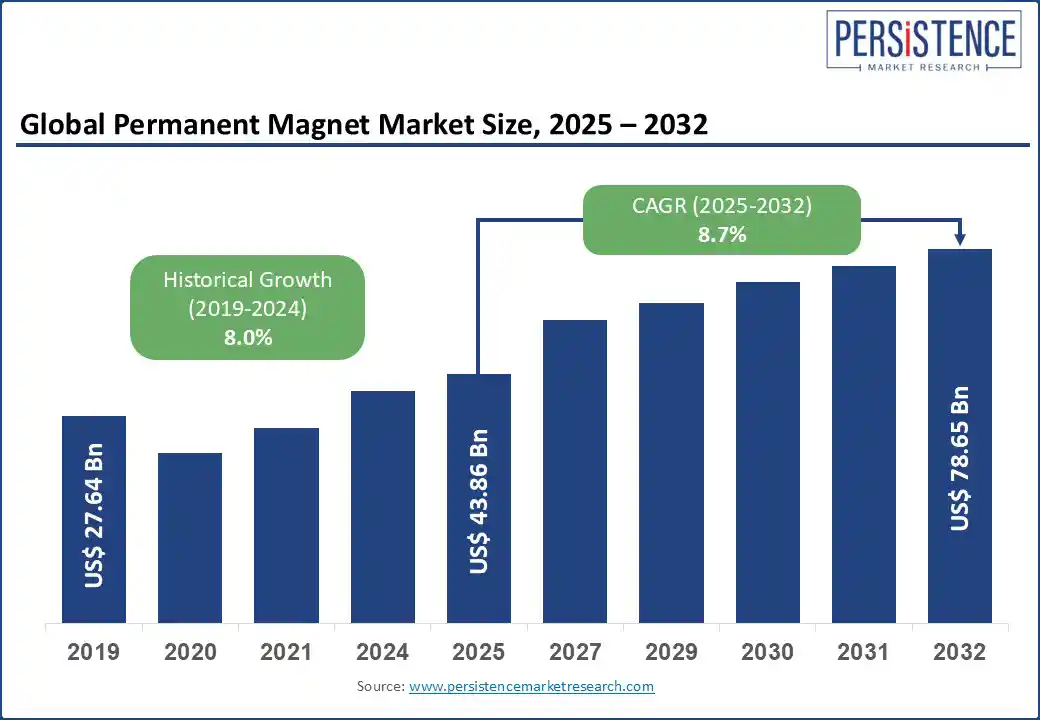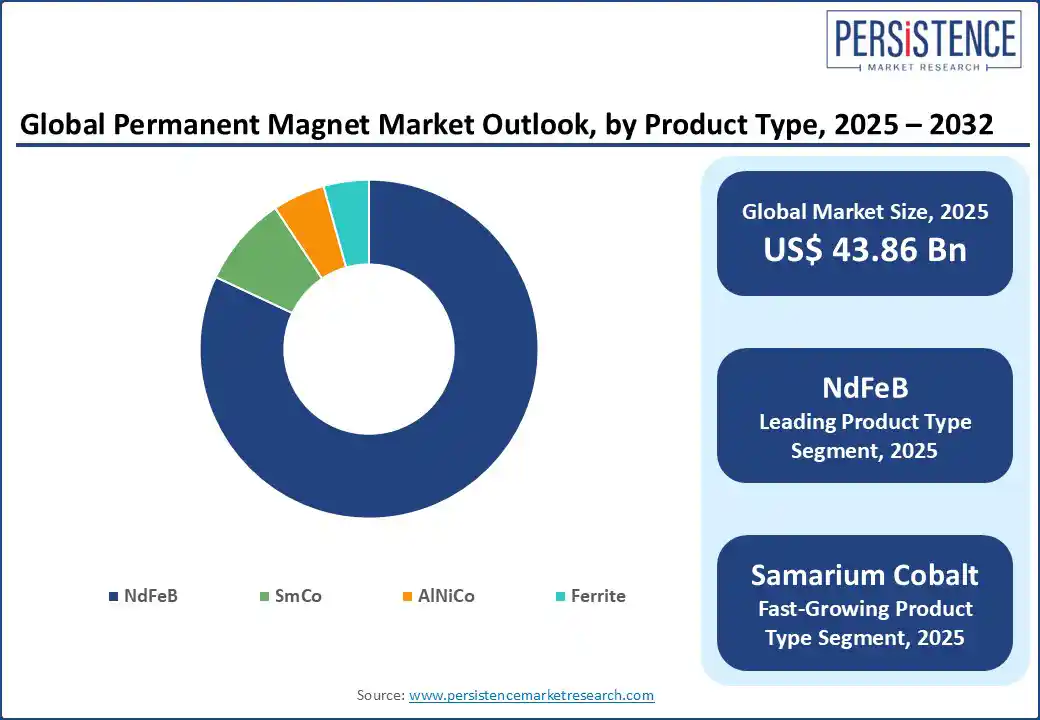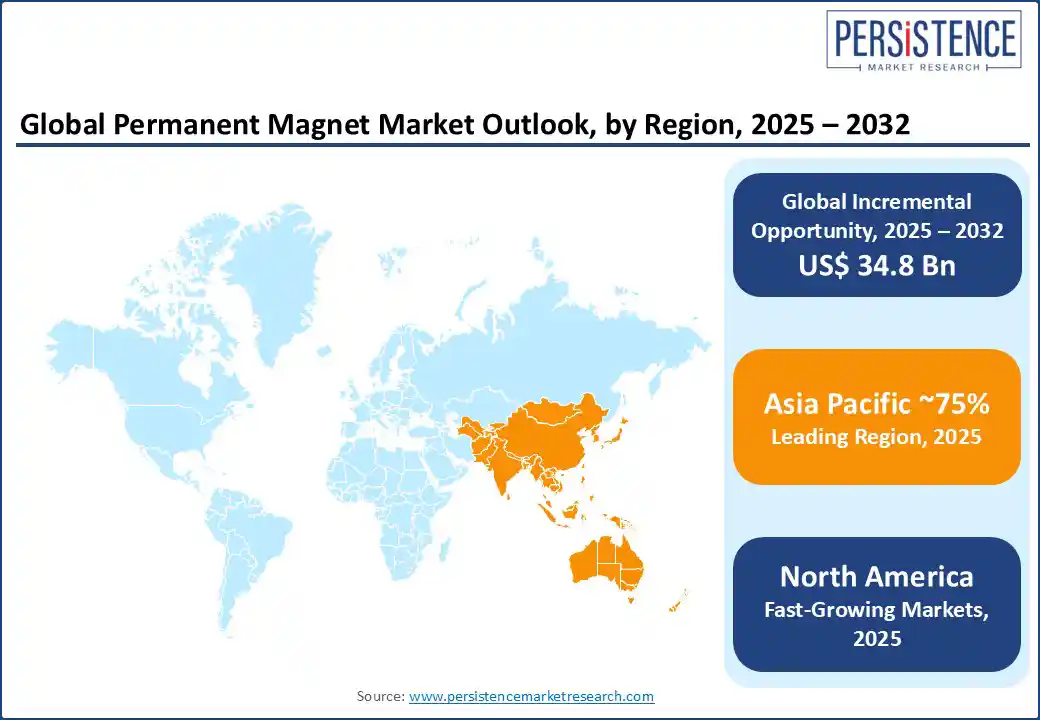ID: PMRREP21979| 192 Pages | 22 Jul 2025 | Format: PDF, Excel, PPT* | Industrial Automation

The global permanent magnet market is likely to be valued at US$ 43.86 Bn in 2025 and is expected to reach US$ 78.65 Bn, growing at a CAGR of 8.7% by 2032. The rise in popularity of electric vehicles (EVs) is driving the need for permanent magnets in the EV industry. These magnets create a magnetic field without an external power source, making them essential in various high-efficiency applications. The magnetic field caused by permanent magnets converts the electricity into torque, making it a critical component for EVs. According to IEA, EV use has continued to grow rapidly worldwide, with the global sales increasing from 716,000 vehicles in 2015 to 17 million vehicles in 2024.

Key Highlights:
|
Global Market Attribute |
Key Insights |
|
Permanent magnet market Size (2025E) |
US$ 43.86 Bn |
|
Projected Market Value (2032F) |
US$ 78.65 Bn |
|
Global Market Growth Rate (CAGR 2025 to 2032) |
8.7% |
|
Historical Market Growth Rate (CAGR 2019 to 2024) |
8.0% |
The automotive industry is constantly evolving with advancements in technology. In recent years, the rising demand for EVs has shifted the focus of the automotive industry towards sustainable transportation. The permanent magnets generate their own constant magnetic field, which is used to create the motion in the vehicle. The EVs continue to make progress toward becoming a dominant automotive vehicle globally. Electric car sales in 2023 were 3.5 million higher than in 2022, a 35% year-on-year increase. This indicates robust growth even as many major markets enter a new phase, with uptake shifting from early adopters to the mass market. According to the European Institute of Innovation and Technology, in 2019, about 5,000 tons of permanent magnets were used in EVs worldwide. By 2030, the number may rise to between 40,000 and 70,000 tons on a global level, depending on the anticipated growth scenario.
Geopolitical tensions between China and Western countries are significantly restraining the global permanent magnet market. The permanent magnets are primarily produced from the rare earth elements, which are sourced from mines. China currently dominates the rare earth magnet supply chain, accounting for approximately 90% of global refining and magnet production capacity.
In April 2025, China imposed new export licensing requirements on the 7 critical rare earth elements, such as neodymium, dysprosium, and terbium, and rare-earth magnets used in electric vehicles and high-tech industries. This results in a drop of Chinese exports of rare-earth magnets, by up to 74% in April and over 58% to the U.S., triggering global supply chain disruptions and severe price volatility. The Western companies are connecting with the governments to respond to this situation. For instance, in July 2025, the U.S. Department of Defense invested US$ 400 million to acquire a 15% stake in MP Materials, supporting its expansion of domestic rare-earth mining and building a new magnet processing facility projected to begin operations in 2028.
The rising demand for permanent magnets in the electronics sector presents a major opportunity for market growth. The rise in technology development in smartphones, laptops, wearables, and smart appliances, driving the need for compact, efficient, and high performance devices. This demand for enhanced properties encourages manufacturers to use permanent magnetic in the devices. Neodymium-based magnets are widely used in speakers, vibration motors, sensors, and miniaturized actuators, owing to their superior magnetic strength and lightweight properties. According to the article published in 2023 from the EMS Energy Institute, Pennsylvania State University, NdFeB magnet content in consumer electronic products may be small, but the global market shares for this sector accounts for almost 30% of NdFeB demand, due to a large and continually increasing consumer base. The expansion of 5G infrastructure and IoT devices is further amplifying magnet demand in advanced electronics components. This growing reliance on permanent magnets in high-volume electronic applications is creating profitable opportunities for manufacturers.
NdFeB Magnets Dominate Market with Strong Demand and Strategic Expansion
Neodymium Iron Boron (NdFeB) magnets lead the permanent magnet market, primarily due to their high magnetic strength, energy efficiency, and compact design. These rare earth magnets are widely used in EVs, wind turbines, industrial automation, and consumer electronics.
Global governments are actively encouraging the expansion of NdFeB production to enhance supply chain flexibility and reduce reliance on China. China currently supplies over 85% of global output. Its NdFeB capacity rose from 30,000 tons in 2014 to approximately 260,000 tons in 2024, with further growth expected. In response, the European Union is investing in recycling-based production. For instance, In June 2025, MagREEsource, a French manufacturer of rare earth permanent magnets made from recycled scrap magnetic material, is expanding its factory in Noyarey near Grenoble. The additional 400m² will bring the total facility size to 1,500m² to support its commercial and technological development.
The Booming EV Industry Drives the Demand for the Permanent magnet market
The automotive industry leads the market with a share of around 34%. The rapid increase in the adoption of EVs drives the demand for permanent magnets as a material for construction. Despite the reduction in the use of permanent magnets in engines and drivelines, EVs benefit from applying permanent magnets in BEV powertrains and battery enclosures. The environmental concerns over the use of gas and diesel as fuel drive consumers to choose EVs as an alternative. According to the International Energy Agency, almost 14 million new electric cars were registered globally in 2023, bringing their total number on the road to 40 million. Car sales have increased at a year-on-year rate of 35%. The governments across the world are promoting EV adoption through initiatives. The U.S. Inflation Reduction Act, the EU’s Green Deal, and China’s New Energy Vehicle policy promote EV production through tax incentives, emissions regulations, and the integration of high-performance magnets in EV drivetrains.

North America is strengthening its position through strategic investments and expansions. In response to China’s rare earth export restrictions, which caused a 75% drop in global rare earth magnet exports, the U.S. agencies and private industry are taking decisive steps to secure domestic supply chains. The activities, such as the U.S. Department of Defense's investment to acquire a 15% stake in MP Materials, highlight the government’s strategies. Furthermore, the private industries are expanding their reach by collaborating with other players. For instance, In 2025, Energy Fuels formed a strategic alliance with South Korea’s POSCO International to develop a non-China NdPr oxide supply chain, enabling the production of permanent magnets for over 30,000 EVs annually. The efforts from both the government and market players, fueled by geopolitical trade tensions coupled with the rising EV demand, drive the North America permanent magnet market significantly.
Europe permanent magnet market is shifting towards building a sustainable and resilient structure through targeted recycling initiatives, policy frameworks, and industrial investments. The region currently relies on China for about 98% of its permanent magnet supply.
Considering China’s strategic role in rare earth magnets in 2025, the European Union prioritized the development of local capabilities under the Critical Raw Materials Act. This regulation mandates that by 2030, 25% of the EU’s rare earth demand must be met through recycling, and at least 40% of processing must occur within the region. The regional market players are investing significantly in magnet recycling to meet such regulations. For instance, in March 2025, Heraeus Remloy inaugurated a neodymium magnet recycling plant in Bitterfeld, Germany, with a current capacity of 600 tons per year, expected to double to 1,200 tons.
Asia Pacific is dominating the global industry, with a share of more than 75%, fueled by growing EVs, renewable energy, and electronics demand. Following China’s April 2025 export restrictions, which slashed magnet exports by 75%, the end-users in the region are shifting towards non-Chinese suppliers, often paying $10–$30/kg above Chinese rates, to secure essential NdPr materials used in EV motors.
Despite China’s dominance owing to the export restrictions accelerated local investments and supply chain shifts. These developments affirm Asia Pacific’s market resilience and strategic movement toward supply diversification. For instance, in July 2025, Indian auto company Mahindra & Mahindra and parts maker Uno Minda started supply chain diversification to make rare earth magnets locally to cut reliance on China, as the Indian government draws up incentives for the production of the permanent magnets.

The global permanent magnet market is fairly consolidated, undergoing significant transformation as countries and companies seek to diversify supply chains, reduce dependence on China, and improve material sustainability. China currently dominates the global market, accounting for over 85% of Neodymium-Iron-Boron (NdFeB) magnet production. The rising geopolitical tensions and export restrictions have pushed the highly demanding regions, such as North America and Europe to increase their dependency on recycled magnets and invest in strategic expansions to increase the fragmentation in the market. As applications diversify, market players differentiate through technological capabilities, quality, and application-specific expertise.
Yes, the market is set to reach US$ 78.65 Bn by 2032.
The global growing adoption of EVs is propelling the permanent magnet market growth.
India is estimated to witness a CAGR of 9.0% in the forecast period.
The rising adoption of smart and compact electronic devices presents a significant opportunity for the permanent magnet market.
Shin-Etsu Chemical Co., Ltd. is considered the leading player of the permanent magnet market.
|
Report Attribute |
Details |
|
Forecast Period |
2025 - 2032 |
|
Historical Data Available for |
2019 - 2024 |
|
Market Analysis |
US$ Million for Value Tons for Volume |
|
Key Regions Covered |
|
|
Key Market Segments Covered |
|
|
Key Companies Profiled in the Report |
|
|
Report Coverage |
|
|
Customization & Pricing |
Available upon request |
By Product Type
By End-use
By Region
Delivery Timelines
For more information on this report and its delivery timelines please get in touch with our sales team.
About Author